Jiaze Wang
SceneDecorator: Towards Scene-Oriented Story Generation with Scene Planning and Scene Consistency
Oct 27, 2025Abstract:Recent text-to-image models have revolutionized image generation, but they still struggle with maintaining concept consistency across generated images. While existing works focus on character consistency, they often overlook the crucial role of scenes in storytelling, which restricts their creativity in practice. This paper introduces scene-oriented story generation, addressing two key challenges: (i) scene planning, where current methods fail to ensure scene-level narrative coherence by relying solely on text descriptions, and (ii) scene consistency, which remains largely unexplored in terms of maintaining scene consistency across multiple stories. We propose SceneDecorator, a training-free framework that employs VLM-Guided Scene Planning to ensure narrative coherence across different scenes in a ``global-to-local'' manner, and Long-Term Scene-Sharing Attention to maintain long-term scene consistency and subject diversity across generated stories. Extensive experiments demonstrate the superior performance of SceneDecorator, highlighting its potential to unleash creativity in the fields of arts, films, and games.
UniView: Enhancing Novel View Synthesis From A Single Image By Unifying Reference Features
Sep 05, 2025Abstract:The task of synthesizing novel views from a single image is highly ill-posed due to multiple explanations for unobserved areas. Most current methods tend to generate unseen regions from ambiguity priors and interpolation near input views, which often lead to severe distortions. To address this limitation, we propose a novel model dubbed as UniView, which can leverage reference images from a similar object to provide strong prior information during view synthesis. More specifically, we construct a retrieval and augmentation system and employ a multimodal large language model (MLLM) to assist in selecting reference images that meet our requirements. Additionally, a plug-and-play adapter module with multi-level isolation layers is introduced to dynamically generate reference features for the target views. Moreover, in order to preserve the details of an original input image, we design a decoupled triple attention mechanism, which can effectively align and integrate multi-branch features into the synthesis process. Extensive experiments have demonstrated that our UniView significantly improves novel view synthesis performance and outperforms state-of-the-art methods on the challenging datasets.
Medical Large Vision Language Models with Multi-Image Visual Ability
May 25, 2025Abstract:Medical large vision-language models (LVLMs) have demonstrated promising performance across various single-image question answering (QA) benchmarks, yet their capability in processing multi-image clinical scenarios remains underexplored. Unlike single image based tasks, medical tasks involving multiple images often demand sophisticated visual understanding capabilities, such as temporal reasoning and cross-modal analysis, which are poorly supported by current medical LVLMs. To bridge this critical gap, we present the Med-MIM instruction dataset, comprising 83.2K medical multi-image QA pairs that span four types of multi-image visual abilities (temporal understanding, reasoning, comparison, co-reference). Using this dataset, we fine-tune Mantis and LLaVA-Med, resulting in two specialized medical VLMs: MIM-LLaVA-Med and Med-Mantis, both optimized for multi-image analysis. Additionally, we develop the Med-MIM benchmark to comprehensively evaluate the medical multi-image understanding capabilities of LVLMs. We assess eight popular LVLMs, including our two models, on the Med-MIM benchmark. Experimental results show that both Med-Mantis and MIM-LLaVA-Med achieve superior performance on the held-in and held-out subsets of the Med-MIM benchmark, demonstrating that the Med-MIM instruction dataset effectively enhances LVLMs' multi-image understanding capabilities in the medical domain.
SciVerse: Unveiling the Knowledge Comprehension and Visual Reasoning of LMMs on Multi-modal Scientific Problems
Mar 13, 2025Abstract:The rapid advancement of Large Multi-modal Models (LMMs) has enabled their application in scientific problem-solving, yet their fine-grained capabilities remain under-explored. In this paper, we introduce SciVerse, a multi-modal scientific evaluation benchmark to thoroughly assess LMMs across 5,735 test instances in five distinct versions. We aim to investigate three key dimensions of LMMs: scientific knowledge comprehension, multi-modal content interpretation, and Chain-of-Thought (CoT) reasoning. To unveil whether LMMs possess sufficient scientific expertise, we first transform each problem into three versions containing different levels of knowledge required for solving, i.e., Knowledge-free, -lite, and -rich. Then, to explore how LMMs interpret multi-modal scientific content, we annotate another two versions, i.e., Vision-rich and -only, marking more question information from texts to diagrams. Comparing the results of different versions, SciVerse systematically examines the professional knowledge stock and visual perception skills of LMMs in scientific domains. In addition, to rigorously assess CoT reasoning, we propose a new scientific CoT evaluation strategy, conducting a step-wise assessment on knowledge and logical errors in model outputs. Our extensive evaluation of different LMMs on SciVerse reveals critical limitations in their scientific proficiency and provides new insights into future developments. Project page: https://sciverse-cuhk.github.io
Point Cloud Understanding via Attention-Driven Contrastive Learning
Nov 22, 2024



Abstract:Recently Transformer-based models have advanced point cloud understanding by leveraging self-attention mechanisms, however, these methods often overlook latent information in less prominent regions, leading to increased sensitivity to perturbations and limited global comprehension. To solve this issue, we introduce PointACL, an attention-driven contrastive learning framework designed to address these limitations. Our method employs an attention-driven dynamic masking strategy that guides the model to focus on under-attended regions, enhancing the understanding of global structures within the point cloud. Then we combine the original pre-training loss with a contrastive learning loss, improving feature discrimination and generalization. Extensive experiments validate the effectiveness of PointACL, as it achieves state-of-the-art performance across a variety of 3D understanding tasks, including object classification, part segmentation, and few-shot learning. Specifically, when integrated with different Transformer backbones like Point-MAE and PointGPT, PointACL demonstrates improved performance on datasets such as ScanObjectNN, ModelNet40, and ShapeNetPart. This highlights its superior capability in capturing both global and local features, as well as its enhanced robustness against perturbations and incomplete data.
MagicTailor: Component-Controllable Personalization in Text-to-Image Diffusion Models
Oct 17, 2024Abstract:Recent advancements in text-to-image (T2I) diffusion models have enabled the creation of high-quality images from text prompts, but they still struggle to generate images with precise control over specific visual concepts. Existing approaches can replicate a given concept by learning from reference images, yet they lack the flexibility for fine-grained customization of the individual component within the concept. In this paper, we introduce component-controllable personalization, a novel task that pushes the boundaries of T2I models by allowing users to reconfigure specific components when personalizing visual concepts. This task is particularly challenging due to two primary obstacles: semantic pollution, where unwanted visual elements corrupt the personalized concept, and semantic imbalance, which causes disproportionate learning of the concept and component. To overcome these challenges, we design MagicTailor, an innovative framework that leverages Dynamic Masked Degradation (DM-Deg) to dynamically perturb undesired visual semantics and Dual-Stream Balancing (DS-Bal) to establish a balanced learning paradigm for desired visual semantics. Extensive comparisons, ablations, and analyses demonstrate that MagicTailor not only excels in this challenging task but also holds significant promise for practical applications, paving the way for more nuanced and creative image generation.
SFANet: Spatial-Frequency Attention Network for Weather Forecasting
May 29, 2024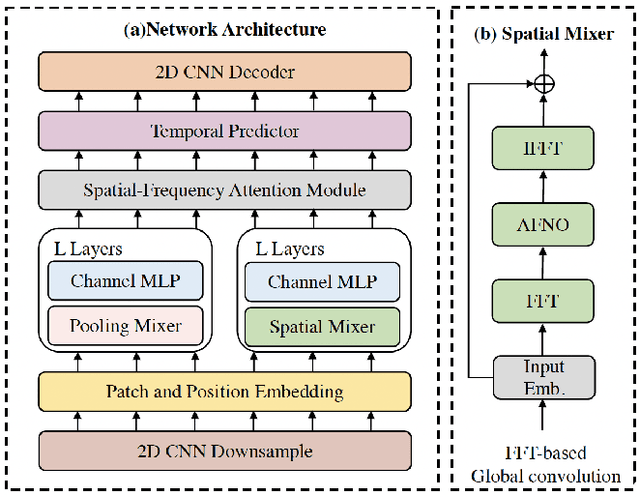

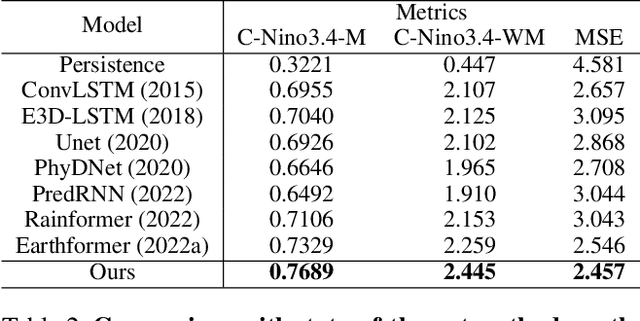
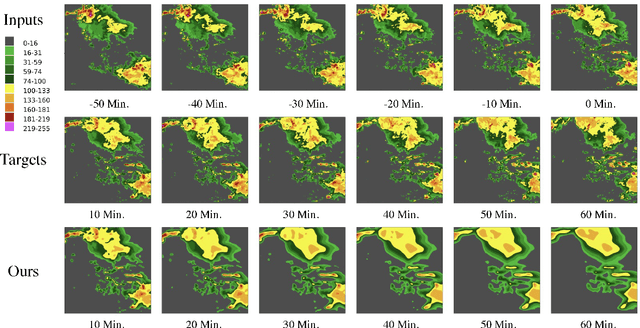
Abstract:Weather forecasting plays a critical role in various sectors, driving decision-making and risk management. However, traditional methods often struggle to capture the complex dynamics of meteorological systems, particularly in the presence of high-resolution data. In this paper, we propose the Spatial-Frequency Attention Network (SFANet), a novel deep learning framework designed to address these challenges and enhance the accuracy of spatiotemporal weather prediction. Drawing inspiration from the limitations of existing methodologies, we present an innovative approach that seamlessly integrates advanced token mixing and attention mechanisms. By leveraging both pooling and spatial mixing strategies, SFANet optimizes the processing of high-dimensional spatiotemporal sequences, preserving inter-component relational information and modeling extensive long-range relationships. To further enhance feature integration, we introduce a novel spatial-frequency attention module, enabling the model to capture intricate cross-modal correlations. Our extensive experimental evaluation on two distinct datasets, the Storm EVent ImageRy (SEVIR) and the Institute for Climate and Application Research (ICAR) - El Ni\~{n}o Southern Oscillation (ENSO) dataset, demonstrates the remarkable performance of SFANet. Notably, SFANet achieves substantial advancements over state-of-the-art methods, showcasing its proficiency in forecasting precipitation patterns and predicting El Ni\~{n}o events.
TripletMix: Triplet Data Augmentation for 3D Understanding
May 28, 2024Abstract:Data augmentation has proven to be a vital tool for enhancing the generalization capabilities of deep learning models, especially in the context of 3D vision where traditional datasets are often limited. Despite previous advancements, existing methods primarily cater to unimodal data scenarios, leaving a gap in the augmentation of multimodal triplet data, which integrates text, images, and point clouds. Simultaneously augmenting all three modalities enhances diversity and improves alignment across modalities, resulting in more comprehensive and robust 3D representations. To address this gap, we propose TripletMix, a novel approach to address the previously unexplored issue of multimodal data augmentation in 3D understanding. TripletMix innovatively applies the principles of mixed-based augmentation to multimodal triplet data, allowing for the preservation and optimization of cross-modal connections. Our proposed TripletMix combines feature-level and input-level augmentations to achieve dual enhancement between raw data and latent features, significantly improving the model's cross-modal understanding and generalization capabilities by ensuring feature consistency and providing diverse and realistic training samples. We demonstrate that TripletMix not only improves the baseline performance of models in various learning scenarios including zero-shot and linear probing classification but also significantly enhances model generalizability. Notably, we improved the zero-shot classification accuracy on ScanObjectNN from 51.3 percent to 61.9 percent, and on Objaverse-LVIS from 46.8 percent to 51.4 percent. Our findings highlight the potential of multimodal data augmentation to significantly advance 3D object recognition and understanding.
SignVTCL: Multi-Modal Continuous Sign Language Recognition Enhanced by Visual-Textual Contrastive Learning
Jan 22, 2024Abstract:Sign language recognition (SLR) plays a vital role in facilitating communication for the hearing-impaired community. SLR is a weakly supervised task where entire videos are annotated with glosses, making it challenging to identify the corresponding gloss within a video segment. Recent studies indicate that the main bottleneck in SLR is the insufficient training caused by the limited availability of large-scale datasets. To address this challenge, we present SignVTCL, a multi-modal continuous sign language recognition framework enhanced by visual-textual contrastive learning, which leverages the full potential of multi-modal data and the generalization ability of language model. SignVTCL integrates multi-modal data (video, keypoints, and optical flow) simultaneously to train a unified visual backbone, thereby yielding more robust visual representations. Furthermore, SignVTCL contains a visual-textual alignment approach incorporating gloss-level and sentence-level alignment to ensure precise correspondence between visual features and glosses at the level of individual glosses and sentence. Experimental results conducted on three datasets, Phoenix-2014, Phoenix-2014T, and CSL-Daily, demonstrate that SignVTCL achieves state-of-the-art results compared with previous methods.
Object-Centric Multiple Object Tracking
Sep 05, 2023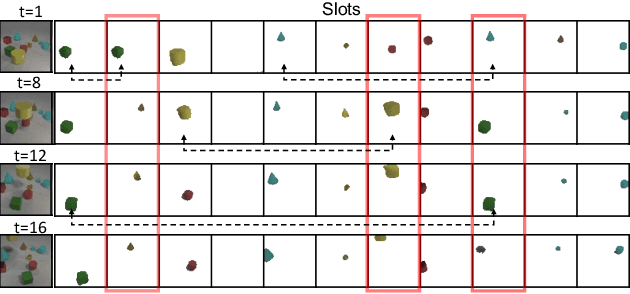
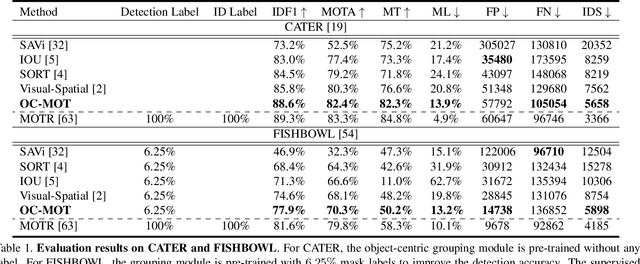


Abstract:Unsupervised object-centric learning methods allow the partitioning of scenes into entities without additional localization information and are excellent candidates for reducing the annotation burden of multiple-object tracking (MOT) pipelines. Unfortunately, they lack two key properties: objects are often split into parts and are not consistently tracked over time. In fact, state-of-the-art models achieve pixel-level accuracy and temporal consistency by relying on supervised object detection with additional ID labels for the association through time. This paper proposes a video object-centric model for MOT. It consists of an index-merge module that adapts the object-centric slots into detection outputs and an object memory module that builds complete object prototypes to handle occlusions. Benefited from object-centric learning, we only require sparse detection labels (0%-6.25%) for object localization and feature binding. Relying on our self-supervised Expectation-Maximization-inspired loss for object association, our approach requires no ID labels. Our experiments significantly narrow the gap between the existing object-centric model and the fully supervised state-of-the-art and outperform several unsupervised trackers.
 Add to Chrome
Add to Chrome Add to Firefox
Add to Firefox Add to Edge
Add to Edge